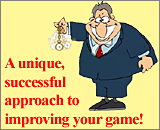|
I am very fortunate to have had a lot of very great teachers and mentors over the years. They have given me lessons, coaching, and advice of all kinds. They include many of the great players of the game:
Nack Ballard •
Gregg Cattanach •
Michael Corbett
Malcolm Davis •
Mary Franks •
Perry Gartner
Jake Jacobs •
Oswold Jacoby •
Neil Kazaross
Laila Leonheart •
Dean Meunch •
John O'Hagan
Howard Ring •
Steve Sax •
Joe Sylvester
David Wells •
Yamin Yamin •
Paul Weaver
Kit Woolsey
|
In the early days of my tournament play, I paid $75 per hour to take lessons, on line, from one of the best players and teachers in the game, Kit Woolsey. And he taught me what I consider to be the single best tool for winning backgammon: Woolsey's Law.
 Simply stated, when you are trying to decide whether to double or not, put yourself in your opponent's shoes and ask yourself if you are sure if it is a take or sure if it is a pass. If you are not sure of either, then for sure, it is a double! Simply stated, when you are trying to decide whether to double or not, put yourself in your opponent's shoes and ask yourself if you are sure if it is a take or sure if it is a pass. If you are not sure of either, then for sure, it is a double!
If you are not sure, after considering the position, match score, relative strength of the opponents, and all factors combined, then if you are reading the situation properly, it probably falls into that category where you are supposed to double and your opponent is supposed to take.
By doubling, you give your opponent the chance to make a mistake and drop the cube. Possibly you are a little off, and he really should drop it, but even then, by giving the cube, you give your opponent the chance to make a mistake and take the cube. Either way, you come out ahead by doubling as opposed to not doubling.
Now, what if you are sure it is a drop ... then, unless you are too good to double (meaning that you are too likely to get gammons as opposed to losing the game), your decision is easy: give the cube.
What if you decide you are sure it is a take? Well, then you must be more careful. Even if it is a take, it is often right to give the cube. Again, he might make a mistake and drop, but even if he does the right thing and takes, it may well be right for you to give the cube anyway.
The best thing about Woolsey's Law is that it solves the problem for when you are not sure ... when you are on the fence. On the fence, give the cube.
I wish there were as good a law for when to take the cube. No one I know has come up with a simple solution for this ... every methodology I have seen for taking includes a tremendous amount of math, skill, and insight, and for the really great and experienced players, they also have the benefit of having a tremendous number of reference positions to help them. (Jake Jacobs can look at a position, tell you the date and time a similar position came up before, and what he had for lunch that day. And then he will often go on to tell you a story about the waitress.)
I did thank Kit for his great lessons by sending him a check (and a donation to support his playing site—FIBS—the first on-line backgammon site), but I keep thanking him all the time for this valuable lesson, and I am happy to pass it on to my friends here.
|

